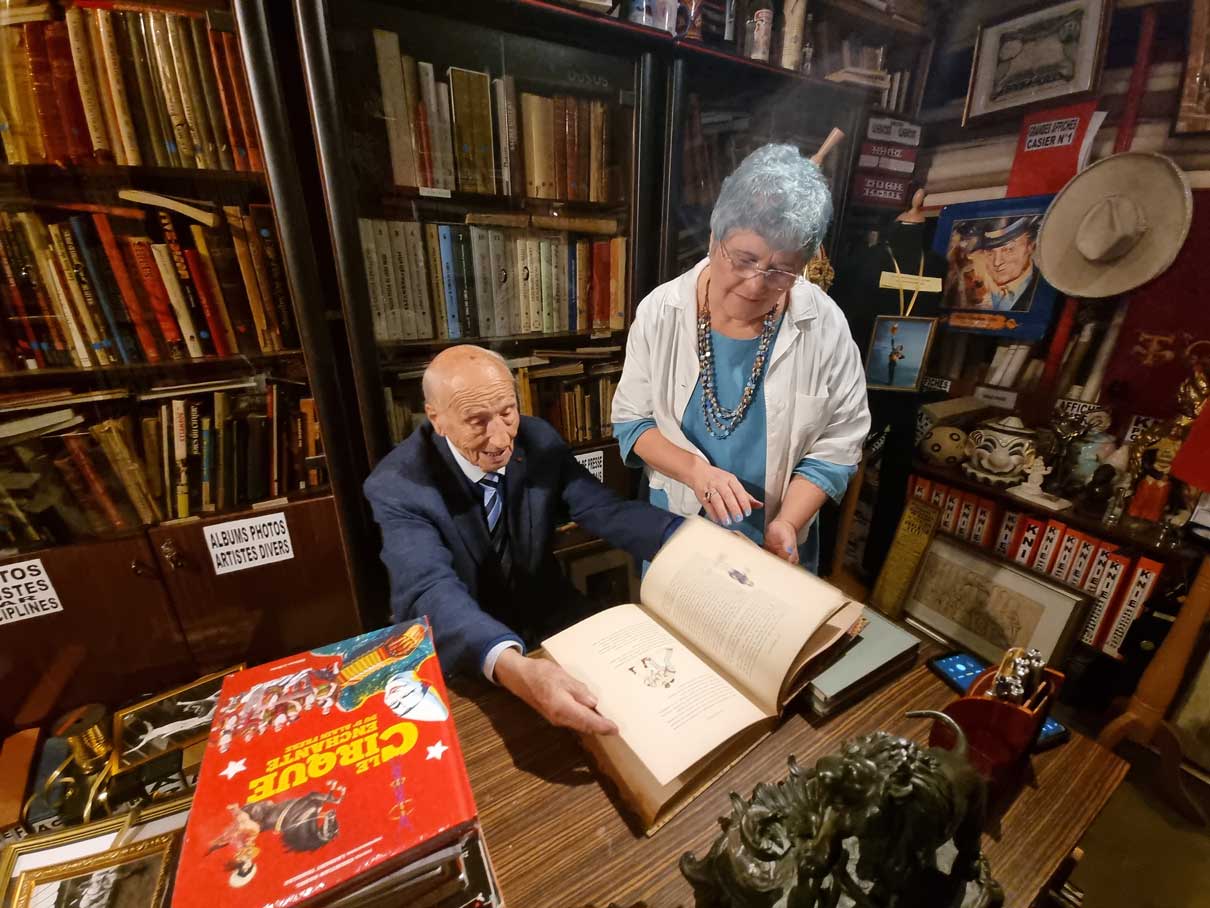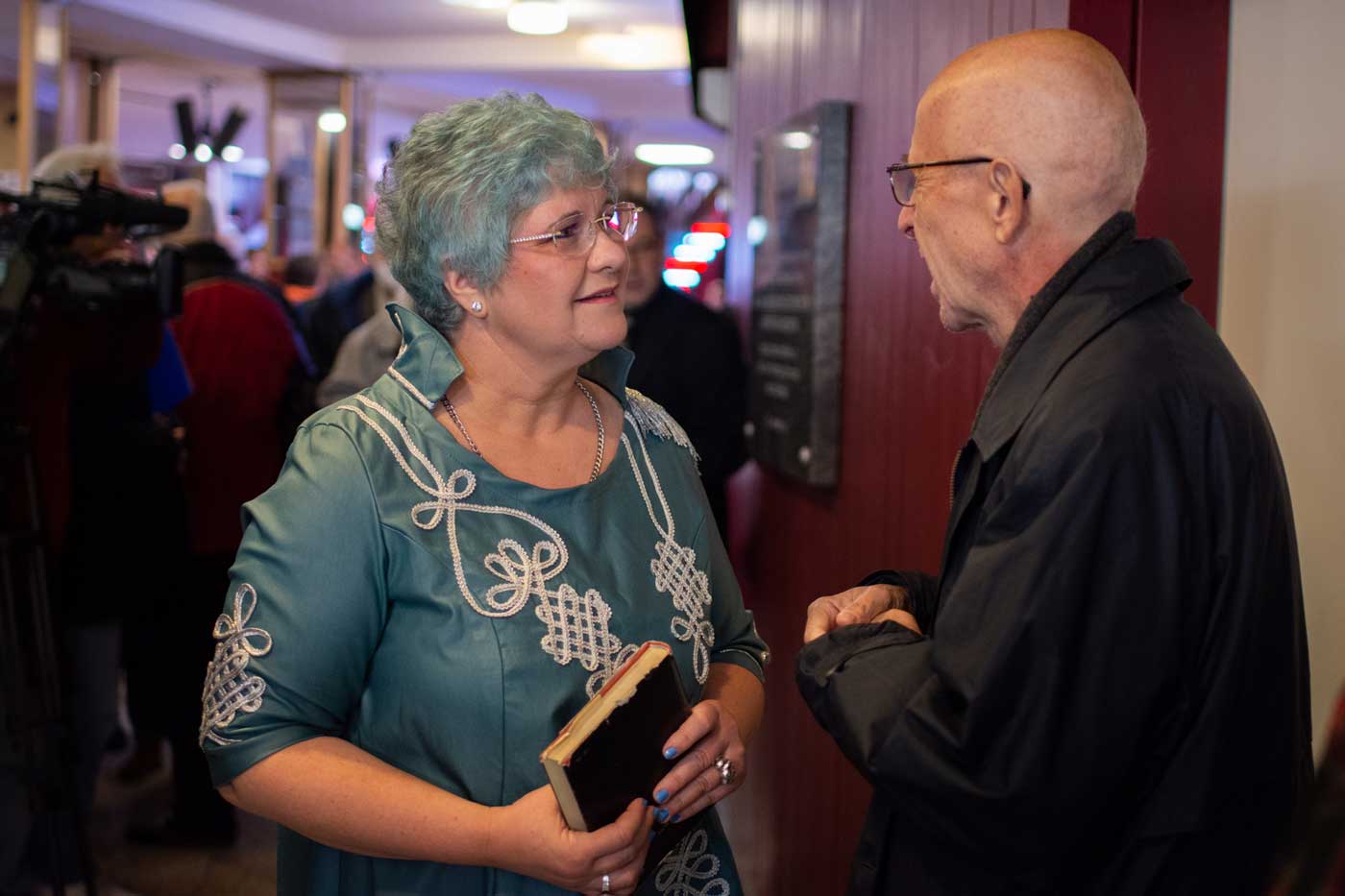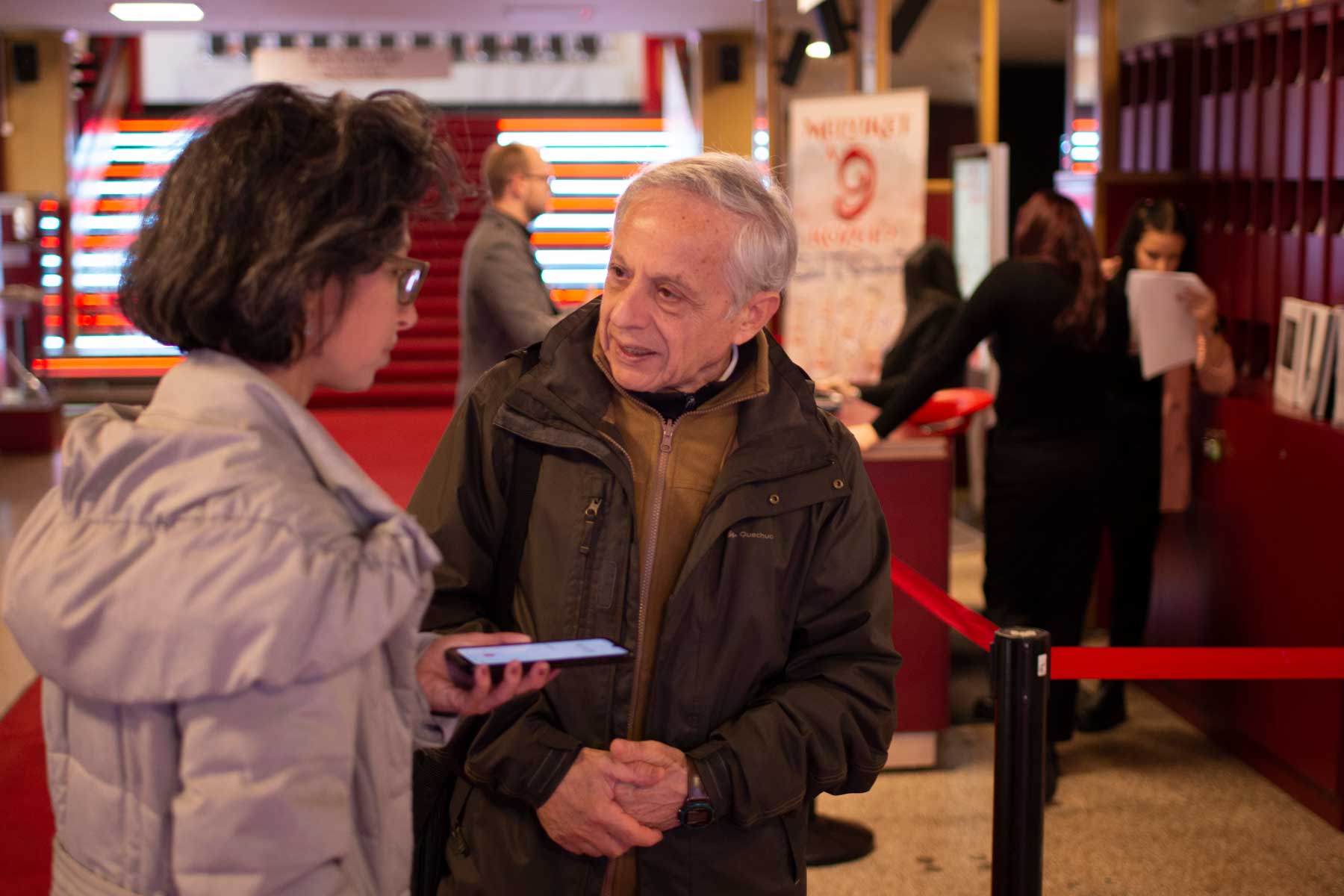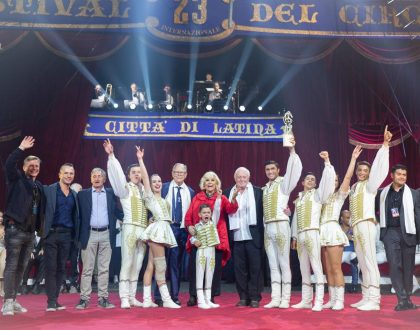konyvtar dot circus dot hu

For the fourth year now, the academic circus repository, or more precisely the library and museum public collection, has been growing within with the National Circus Arts Centre. On the 10th of November 2022, the Museum, Library and Archives of Hungarian Circus Arts was officially established in a ceremony, and we took a look around the library of the museum with the eyes of a museologist on the occasion of the addition of the 1000th book to the collection. Let’s see!

The 1000th volume of the Circus Arts Library was ceremoniously placed on the top shelf of the 6-meter-high circus bookshelf during a performance of a perch act by Russian artists Dimitrii Markin and his father Roman Markin. Photo by Melinda Farkas, assistant museologist
We, museum staff with degrees in humanities, also have a view of the library through the positions of our workstations and our daily research. We know that the library is an indispensable field for academic work, and its cataloguing system is a puzzle, but as book lovers, our hearts leap when we hold any one of the 1000 copies, whatever the language: it is clear that the centuries of the world history of circus arts and culture are in our office. That is why it is both a challenge and a good opportunity to write a report on the celebration of circus in our partner profession.
In the offices of the academic circus repository, 599 catalogued books are currently on the shelves and in the bookcases. Our online catalogue is available to everyone on this website: https://konyvtar.circus.hu/ A reference book, created with thorough academic research, and available electronically on the internet, gives an account of the background of the creation of the library, its collection and the public functions of this institutional library in general. The book “A case study of the library of the National Circus Arts Centre” by Dr. habil. Péter Kiszl, and produced by the academic works of the Institute of Library and Information Science of the ELTE BTK, demonstrating an exemplary cooperation with the National Circus Arts Centre, at its request.
In the summer of 2022, with the expansion of international relations with the academic repository, our book collection has grown significantly. Thanks to the support of Dr. Alain Frére, Pascal Jacob, Gilles Maignant, Filippo Riminucci, Cor Martens, Davio Casartelli, Antonio Giarola and other circus experts, researchers and collectors, our international library of circus art has been expanded by nearly 700 volumes in just a few months, and the processing and cataloguing of these volumes has already begun and is ongoing. What we do know for sure, is that our library now offers circus books, educational publications, programmes, fiction, children’s books, comics, art albums, etc. in 17 languages.
Our 1000th circus book is from the collection of Pascal Jacob, circus historian, writer and collector, Baron de Vaux: “Ecuyers et écuyères. Histoire des cirques d’Europe (1680-1891)”. This rare book on the history of the circus, in French, with 280 portraits and illustrations, was published in Paris in 1893. Written in a monographic style, the book, with etchings and textual descriptions of the men and women who practised circus horse riding, focuses on the relationship between man and the horse trained in the circus environment. The book focuses on the famous circus performers of the 19th century, including a Hungarian aspect: the portrayal of Ilona de Széles, circus performer and Eduard Wulff, circus director and circus performer. The topical descriptions of their activities provide useful contributions to Hungarian circus history.
From our ever-expanding library, we can only highlight a few interesting items to illustrate the diversity of our specialist books.
A basic work on the history of the circus is Carl Hagenbeck’s “Von Tieren und Menschen”. This book, published in 1925 and containing a portrait of the author in a hat, describes the techniques of the humane method of taming animals: gentle taming. Hagenbeck presents circus examples of the friendly coexistence and training of animals, an important part of the circus and the spirit in which the Capital Circus of Budapest operates today.
The album of circus stamps ‘Filatelia Circense’, compiled by the Catalan art historian and circus researcher Genís Matabosch, is a real gem. The small booklet presents the largest collection of circus-themed stamps in the world, with more than 900 stamps from 185 countries from 1989 to 2009, from Andorra to Zambia. It is worth mentioning that the circus museum collection also boasts a number of German, Hungarian and Mongolian circus stamps.
The album of circus stamps ‘Filatelia Circense’, compiled by the Catalan art historian and circus researcher Genís Matabosch, is a real gem. The small booklet presents the largest collection of circus-themed stamps in the world, with more than 900 stamps from 185 countries from 1989 to 2009, from Andorra to Zambia. It is worth mentioning that the circus museum collection also boasts a number of German, Hungarian and Mongolian circus stamps.
Dave Finnigan: “The Complete Juggler. All the Steps from Beginner to Professional”, published in 1987, is an outstandingly effective example of a professional juggler’s knowledge-sharing, with nearly 600 pages. The creative cartoon illustrations that dominate the manual are very clear and easy to understand illustrations that inspire even the museologists to throw a ball.
‘Ric Hochet: Coups De Griffes Chez Bouglione’ – a French-language comicbook about the adventures of young detective hero Ric Hochet as he investigates a crime at the circus. The setting is the travelling circus of Bouglione, one of the most famous French circus dynasties, and the family currently runs the most beautiful circus building in Europe, the Cirque d’Hiver in Paris. Published in 1977, this book is a treasure for both Belgian-French comics and circus lovers. In keeping with our library’s collection, it will find a place in the co-collections, as will the Krúdy book below. Showing, how the circus has a rich cultural history.
A generous gift from Dr. Alain Frére, circus historian, collector and co-founder of the Monte Carlo International Circus Festival, is the original 1889 Paris edition of Hugues le Roux’s “Les jeux du cirque et la vie foraine”, now one of the most valuable reference books in our library.

Dr Alain Frère welcomed our staff and presented his valuable donations of books and prints to head museologist Emese Joó in his private collection (Musée du Cirque du Dr Alain Frère) in Tourrette-Levens, France, in September 2022. Photo: Susy Eötvös, circus artist, international referent
Jules Garnier created the colourful, exquisitely crafted prints for this museum-worthy volume. Almost every page of this 250-page reference book features illustrations that bring to life the circus world of the 19th century: from fairgrounds to the hippodrome, the reality of the circus with its horse riders, balancers, acrobats and clowns.
The 1982 edition of Gyula Krúdy’s youth novel “The Circus King” became the 1001st volume of our library. In this short publication, which collects the writer’s early writings, the short story is a literary portrayal of the life of a travelling circus. When catalogued, Krúdy’s work will be placed in the section of co-collections, under the heading of fiction. Our library collects all manifestations and imprints of the circus, including fiction. This alone shows that our rich library system has a place for every volume, including the 700 books that have just arrived.
The 1001st volume of our circus library was a gift from Imre Kiss, retired director of the Hungarian Museum of Trade and Hospitality, with the inspiration that this beautiful story could be turned into a circus performance.

Imre Kiss, retired director, and Emese Joó, chief museologist, discussing the circus’s potential uses at the reception of Volume 1001
A little something extra
Attraction! We ourselves were impressed by the shelving of the 1000th book, as the modest bookshelves of our office were bolted together vertically, one on top of the other. They were a breathtaking sight, since then we view them with pride as having been in the circus ring, realising one of the greatest dreams of anyone living within the world of circus. Animating and moving objects is essentially puppet theatre and cinematography, but in a circus, a live performing arts institution, it is commonplace. Here, wonder is commonplace, which is why it’s a special place to work.
To celebrate our 1000th book, we also wanted to know how our invited guests felt and what they thought of the event. We interviewed some of the librarians and archivists, and we also asked circus artists. They all showed curiosity and openness. Dr. Éva Juhász, general director of the Library, Archives and Art Collection of the Hungarian University of Fine Arts, former circus librarian, who herself was actively involved in the founding of the circus library, confirmed the importance of the event and the uniqueness of the meeting of academia and art. Zsolt Osváth, Vice President of the Association of Higher Education Archives, underlined the unique importance of the professional public collection of a performing arts institution. Etele Szüts, director of the OSZK Library Institute, commented on the importance of collecting circus heritage in an academic manner and making it available to the public as a public treasure.

On the occasion of the Book Festival, Director Etele Szüts was interviewed by assistant museologist Melinda Farkas about the development of the circus library
György Losonczi, György Zsilák and Vladimír Laczkó were interviewed as our circus artist guests. We are honoured that they accepted the invitation and spoke highly of the library collection. György Losonczi, teacher and artist, drew attention to the academic side of circus. “An academic approach to the circus profession is very important and helps to develop the profession and shape its future. I think it is important that this concept has come this far.” Juggler, circus artist György Zsilák spoke about his passion for private collecting and how the world of circus and the books related to it are a source of wonder for him. “Actually, I’m a bit of an exaggerator, but it’s just my age, this strange disease or homesickness, I should say.” The importance of the library was underlined by mime artist Vladimir Laczkó, who recalls that there have been attempts to do this in the history of the circus institution, but it has not been done before, not with such careful attention.

On the occasion of the book festival, the circus library development, mime artist Vladimir Laczkó was interviewed by assistant museologist Kinga Varga
We see from these comments, how beautiful it is when the world of circus art and the world of academics meet, how much there is to connect, and how the boundaries we perceive can be crossed and hold fruitful possibilities for cooperation if we listen to each other. And with the Circus Arts Centre, this is what is happening now.
Text by Melinda Farkas, Emese Joó, Kinga Varga, Szandra Szonday
Translation by David Könyöt, Ancsa Schneller
Photo by Nikol Fuszka













